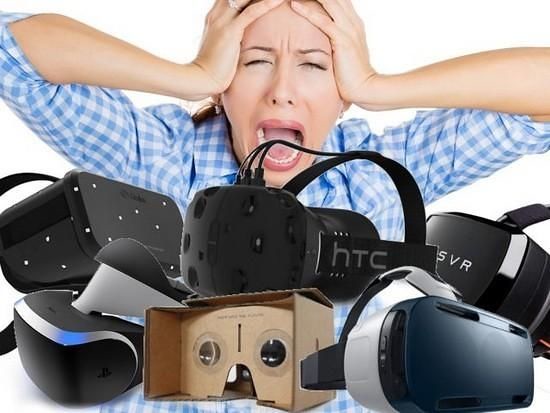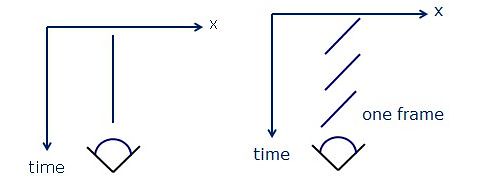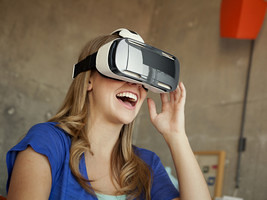"Editor's note" the writer @ the River Tiber, VR industry.

With the rise of virtual reality, now doing virtual reality vendors in China has also increased. But I often hear the experience indicated to me: he put on foreign manufacturers such as the Oculus, Sony VR head and Valve when the experience is wonderful, but put on domestic VR Head not moving well, moving you may feel extremely dizzy, why is that? According to the general opinion, VR head is nothing more than head-mounted display, motion sickness (Motion Sickness) what the hell is going on here?
In fact man's Vertigo of VR is to a large extent, and seasickness patches does not make any difference: human ear's vestibular system the motion and Visual system is inconsistent, will be in the brain "fights"-people will feel light-headed. In General, the motion is divided into three types:
You see, felt no move: for instance, playing FPS games is the case;
You feel moved, but saw no action: for example seasick for motion sickness motion sickness is the case;
Sensation of movement and do not match the movement of the saw: centrifuge training astronauts do when they encounter such a situation.
For VR, the situation may be more complicated. User full vision is covered with VR, VR Head try to deceive you into another world, at which point the thing is more than just the Visual system in the perspective of a picture on the screen, but the entire field of vision, in this case, VR causes motion there will be a variety of factors.
The first factor is, of course, your body movement and you observed from the perspective of the movement do not match.
VR ride for example you when visually at high speed, but the vestibular system says you're not moving, this will cause dizziness. Logically, no different from the dizziness caused by playing FPS games, everyone will have a different feel.
The second very important reason, head movement and Visual observations to the head did not match.
The focus of this is what we want to say today, VR can be improved technically part. This consists of two parts: the delay between frames and frame delay.
Delay between frames is easy to understand. Human head and a corresponding change in vision is extremely sensitive. If a user's head turned, with corresponding view rotational delay, only a very slight delay I can feel it. How small is it? Research has shown that head movement and vision of a latency than 20ms, otherwise it will be very obvious.
Don't underestimate 20ms: head movement speed is actually easy to hundreds of degrees per second. Assuming the head rotation speed to 100 degrees per second (in fact it just turns to achieve this speed), 20ms lag means that the objects from the perspective of the rotational delay is 2 degrees, hand extended, thumb, thumb's width is about 2 degrees.
Delay time 20ms for VR is a very big challenge. First of all devices need to be sufficiently precise way to measure head rotation speed, angle and distance, this can be done using inertial gyroscopes (responsive but poor accuracy) or optical methods to achieve. And then the computer need to render out of the picture, the display also needs to show pictures in a timely manner, this need to complete in under 20ms. Accordingly, if each frame displays time distance frame for more than 20ms, then the same to the human eye will be delayed. Therefore, VR Head screen refresh rate should be over 50FPS, 60FPS is a base line for the time being. All of this in such a short period of time, which itself is a huge challenge.
So is simply to increase the frame rate to above 60FPS, desperate to delay less than 20ms can it? In fact, other than the delay between frames, VR causes of Vertigo are caused by more complex. I use some illustration below shows.

We can see, left this Zhang figure is real of world in the, a objects from left to right mobile Shi eyes see of situation: with time of over, objects of track is a article line; and right of figure is is any a display displayed out of situation: objects of image in each a points displayed a time zhihou, on jumped to Xia a points; it is not is continuous of movement. FENDI iPhone 6 Plus Case
But once the head movement, so the human eye will also result in the display of objects relative to the motion, then alters the trajectories of objects in the eyes of people like:

Right head left, stationary objects trajectory becomes a right like this, is no longer a point, but at the end of each frame jump back to it "should" be in position. However, the phenomenon of persistence of vision of the human eye will keep the previous frame and the frame of the image, so the image can cause ghosting, resulting in dizziness.
If we assume that 60hz refresh rate, head rotation speed of 120 degrees/second, then head inside a frame of 2 degrees, DK2 resolution within a frame delay of 19 pixels, head of images will be displayed at this time was rather vague. The higher the resolution, the problem is more serious. Take into account the theoretical limit of resolution of the human eye, within a frame delay will produce 600 pixels.
How to solve this problem? Want to make image more contiguous objects move, and most simply, the best way is to increase the refresh rate.
From 60 to 90, 120, and 200 ... ... May last into the 1000hz, where our visual system the total can not tell the real or virtual. It is clear that we are not able to set the refresh rate to 1000hz, Oculus Rift CV1 now and HTC Vive 90hz refresh rate, and the Sony Project Morpheus is the 120hz the refresh rate.
Another option is to debase the afterglow (Persistence).
Afterglow (Persistence) is the concept of a CRT display. CRT monitors are electron beam excitation phosphors on the screen, so CRT display only within a very short period of time a pixel of each frame is light, the remainder of the pixel is darker, schemes are as follows:

Can see the LCD display, each pixel in the frame is always glowing, liquid crystal displays called "afterglow" (Full Persistence).

This picture is only half the time in the Middle pixel light while the picture on the right is the ideal case only a very short period of time the screen glows, or "afterglow zero" (Zero Persistence). Due to the persistence of vision effect to the human eye, refresh rate is high enough to be noticed screen only every frame is very light for a short time. But in order to make up for the lack of brightness and luminous intensity of pixels within each frame has been greatly enhanced.
Low light display on the meaning of VR is, first move the tracks closer to the physical object when the real trajectory of the world:

Head movements of the ghosting can be significantly reduced. Premise that same head of 120 degrees/sec, 60hz display refresh rate, within the frame of screens shine 2ms, measured in DK2 and perspective, then shine 2ms head observed by the human eye Visual lag is only 2 megapixel, Vertigo and with it.
But we all know the basic principles of LCD: selective through the LCD flips through the light. This means that the LCD is difficult to use the low-light display.

(TN-LCD the basic principles)
Also have the fastest response time LCD flip 2-4ms, principle of backlit led LCD can't do black. Compared to conventional CRT monitors is a natural low-light displays.
To solve this problem, VR must use the active luminous display like OLED. Because each pixel is active light so OLED screen can do low light.
In fact, Oculus and the Valve using the low rays of the AMOLED display, Sony uses its own OLED display. Most domestic VR head using conventional LCD displays, so Vertigo is caused by its very nature.
Low light is not good. It also can cause side effects: because each frame is displayed for a short time, so the trajectory of moving object shown is intermittent, Visual system will consider it as a different object, and in the case of the display to full brightness, the Visual system has plenty of time to be defined for the same object. In this sense, it's a trade-off: in the settlement of ghosting and motion at the same time, low light blinking display can result in head when moving objects and jump.
Well, with all that said, I think we all understand: two screens, virtual reality is not in front of the eyes and a gyroscope can take care of it. This hope that domestic manufacturers can sink good products, basic experience of virtual reality, we can like Huawei smartphone from Apple to Google to millet.
Disclaimer: this article references in the technical description the Oculus Chief Scientist Michael Abrash's work, some of the pictures from his blog in the Valve, the original address.

380 votes
Gear VR
Gear VR gave me the feeling is similar to popular smart watch, VR equipment there is no ability to completely replace other electronic equipment, especially Gear VR itself also needs to rely on a Samsung Smartphone, and if it is in use, there is an incoming call, SMS or email, users will also need to answer phone out from Gear VR treatment. FENDI plus case
View details of the voting >>

No comments:
Post a Comment